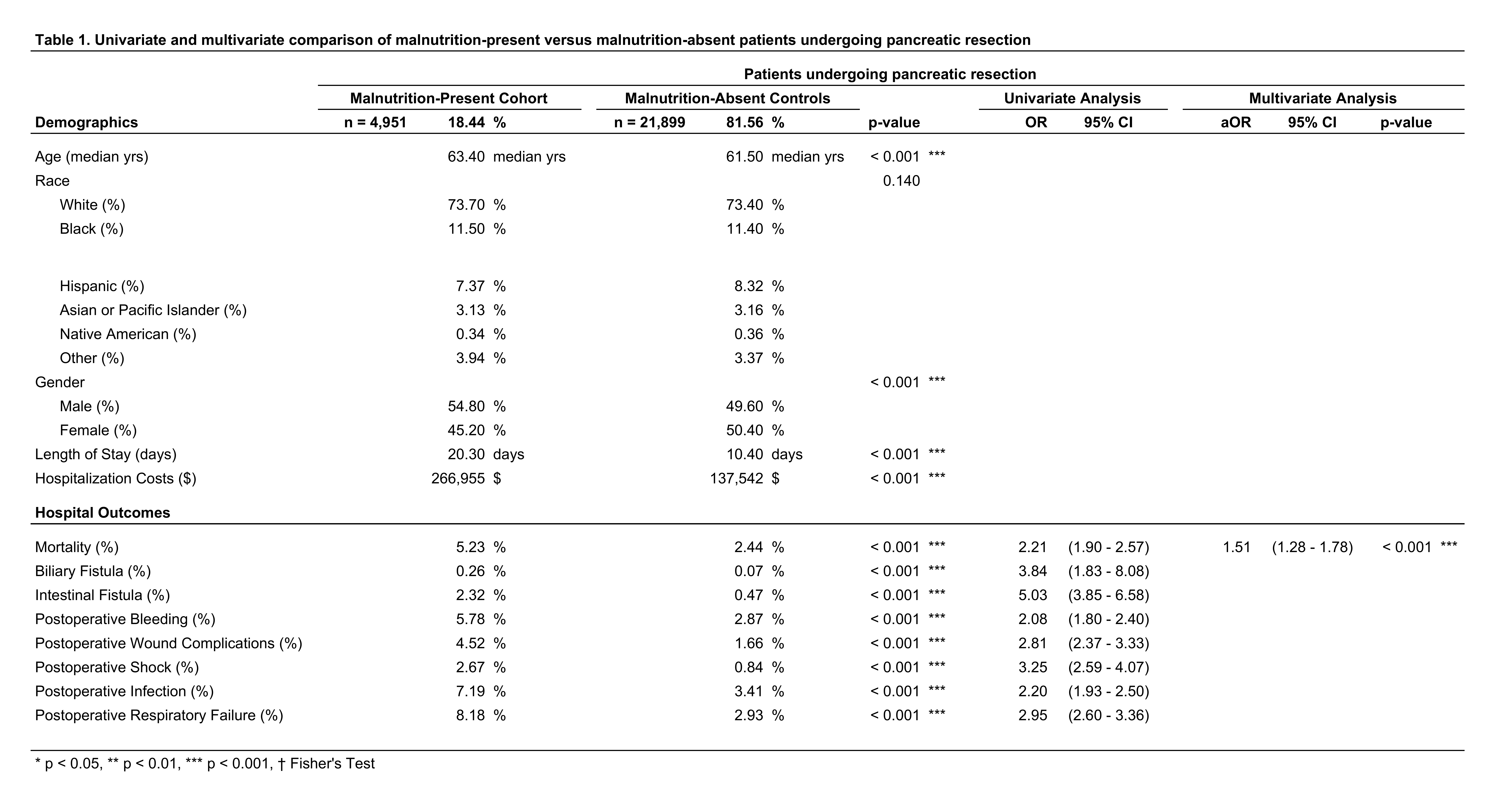THE CLINICAL IMPACT OF MALNUTRITION ON THE POSTOPERATIVE OUTCOMES OF PATIENTS UNDERGOING PANCREATIC RESECTION: ANALYSIS OF 2011-2017 US HOSPITAL
David U. Lee*, Gregory H. Fan, Raffi Karagozian
Tufts Medical Center, Boston, MA
Background & Aims: Pancreatic resection is indicated in various pancreatic pathologies including pancreatic cancers, space-occupying lesions, refractory cysts, and other pancreatic disorders. Given that the presence of malnutrition is highly prevalent in patients with pancreatic insufficiency/disorders, it is important to evaluate the effect of malnutrition on the postoperative outcomes of patients undergoing pancreatic resection
Method: The 2011-2017 National inpatient Sample was used to isolate inpatient cases (age'‰¥18y) with pancreatic resection (including proximal pancreatectomy, distal pancreatectomy, radical subtotal pancreatectomy, radical pancreatectomy, total pancreatectomy, and unspecified pancreatectomy), which were stratified by malnutrition (composite of protein-calorie malnutrition, sarcopenia, and weight loss/cachexia). The endpoints included mortality, length of stay (LOS), hospitalization costs, and postoperative complications.
Results: Of the inpatient pancreatic resection cases, 4951 had malnutrition and 21899 did not have malnutrition. In terms of demographics, the malnutrition cohort was older (63.4 vs 61.5y p<0.01) and was more likely to be male (54.8 vs 49.6% p<0.01). Mortality was higher in the malnutrition cohort (5.23 vs 2.44% p<0.01, OR 2.21 95%CI 1.90-2.57), as were LOS (20.3 vs 10.4d p<0.01) and hospitalization costs ($266,955 vs $137,542 p<0.01). In terms of postoperative complications, the malnutrition cohort had higher incidences of biliary fistula (0.26 vs 0.07% p<0.01, OR 3.84 95%CI 1.83-8.08), intestinal fistula (2.32 vs 0.47% p<0.01, OR 5.03 95%CI 3.85-6.58), bleeding complications (5.78 vs 2.87% p<0.01, OR 2.08 95%CI 1.80-2.40), wound complications (4.52 vs 1.66% p<0.01, OR 2.81 95%CI 2.37-3.33), nonspecific shock (2.67 vs 0.84% p<0.01, OR 3.25 95%CI 2.59-4.07), postoperative infection (7.19 vs 3.41% p<0.01, OR 2.20 95%CI 1.93-2.50), and postoperative respiratory failure (8.18 vs 2.93% p<0.01, OR 2.95 95%CI 2.60-3.36). A multivariate model that included demographics, postoperative complications, and pancreas etiologies showed that malnutrition was associated with postoperative death (p<0.01, aOR 1.51 95%CI 1.28-1.78).
Conclusion: As evidenced by this study, the presence of malnutrition results in increased postoperative death and complications following pancreatic resection. Therefore, these patients require early involvement by pancreatic and nutritional specialists, followed by aggressive nutrition repletion therapies and close peri and post-operative surveillance of surgical complications.
This figure demonstrates the multivariate model of postoperative mortality in patients undergoing pancreatic resection using malnutrition as an independent variable
This table demonstrates the univariate and multivariate comparison of malnutrition-present and malnutrition-absent patients undergoing pancreatic resection
Back to 2021 Abstracts
